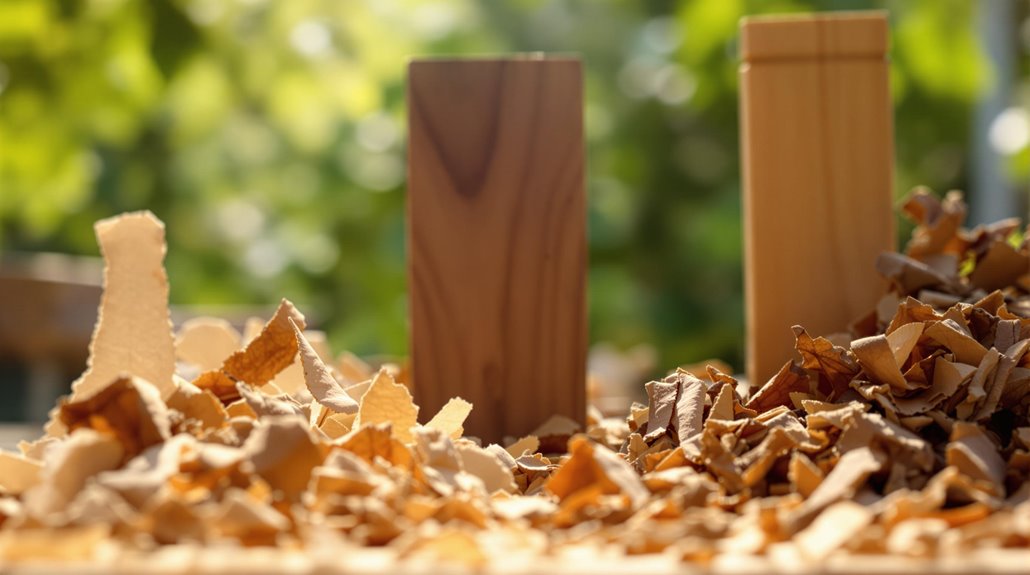Balsa wood is renowned for being exceptionally lightweight yet strong, with a density of approximately 160 kg/m³. This unique combination yields a high strength-to-weight ratio, making it an ideal material for model airplanes, architectural designs, and various lightweight equipment. Its characteristics include a fine, straight grain, a pale appearance with pink or tan hues, and a coarse, even texture. While balsa is exemplary in lightweight applications, other woods like cedar and redwood offer different benefits, such as durability and decay resistance, which are also notable. There is more to explore about alternative woods suitable for various uses.
Balsa Wood Characteristics
Balsa wood, renowned for its unique characteristics, exhibits a pale, off-white appearance with subtle hues of light pink or tan. Its straight and fine grain, occasionally presenting a slightly wavy pattern, contributes to its aesthetic appeal. The coarse and even texture, attributed to large sap conducting vessels, enhances its suitability for various applications. Balsa wood is exceptionally easy to work with, allowing for precise cutting, carving, and shaping, while providing a silky finish when finely sanded. With a lightweight density typically around 160 kg/m³ and a high strength-to-weight ratio, it remains strong despite its softness. These properties make balsa wood ideal for model airplanes, architectural models, and lightweight sporting equipment, showcasing its versatility in craftsmanship and engineering.
Advantages of Redwood
Redwood stands out as an exceptional choice in the domain of construction and woodworking, thanks to its remarkable stability and durability. Its low shrinkage minimizes warping, ensuring excellent paintability, while its minimal seasonal movement enhances stability in various environmental conditions. Naturally resistant to decay and insect attacks, redwood projects maintain their integrity over time. In addition, redwood exhibits fire resistance, enduring direct exposure without visible charring. With a decent strength-to-weight ratio, its moderate strength and stiffness make it practical for various applications. Aesthetically, redwood's rich red-brown color and straight grain contribute to its appeal, while its lightweight nature facilitates ease of handling. Moreover, redwood is sustainable, environmentally friendly, and requires no special maintenance, solidifying its status as a preferred building material.
Properties of Cedar
Cedar is renowned for its natural insect resistance, primarily due to the presence of natural oils that repel pests such as termites and carpenter ants. This intrinsic quality, combined with its exceptional weather-resistant properties, makes cedar an ideal choice for outdoor applications, as it can withstand harsh environmental conditions without significant deterioration. The combination of durability and resistance to decay guarantees that cedar maintains its structural integrity over time, making it a preferred material in construction and landscaping.
Natural Insect Resistance
Many species of wood exhibit natural insect resistance, but cedar stands out due to its remarkable ability to repel a wide variety of pests. This wood effectively deters mosquitoes, spiders, and various fabric-damaging insects, including clothing moths and carpet beetles. The aromatic compounds found in cedarwood oil, such as cedrol and cedrene, disrupt the olfactory receptors of pests, causing disorientation and driving them away. In addition, cedar's volatile oils are lethal to pest larvae, particularly those affecting stored fabrics. Research has demonstrated that cedarwood oil can achieve a knockdown effect on mosquitoes and cockroaches, with effectiveness ranging from 20% to 80%. Consequently, cedar serves as a natural solution for pest prevention, safeguarding garments and food sources alike.
Weather-Resistant Properties**
The impressive characteristics of cedar extend beyond its natural insect resistance to encompass remarkable weather-resistant properties. Cedar wood can endure up to 30 years with routine maintenance, although its longevity is influenced by specific weather conditions. In dry climates, cedar is susceptible to UV radiation, which can cause brittleness; therefore, applying UV-resistant coatings is advisable. Conversely, in wet climates, high humidity may lead to mold and rot, necessitating regular maintenance and water-resistant treatments like TWP 200® Series. In snowy environments, while cedar roofs resist ice and snow, they require thorough inspections to prevent damage from heavy snow loads. Overall, consistent care and protective applications are vital for maximizing cedar's weather resistance across diverse climates.
Benefits of Cypress
Although various wood types offer unique advantages, cypress stands out due to its exceptional durability and water resistance. This highly stable wood is naturally resistant to decay, rot, and insect attacks, thanks to its preservative oils, such as cypressene. Its ability to endure harsh environments, including extreme heat and humidity, makes it suitable for both indoor and outdoor applications. Additionally, cypress possesses a natural resistance to moisture, making it ideal for areas prone to water exposure, such as decks and outdoor furniture. Its appealing yellowish-brown color and straight grains contribute to its aesthetic value, while its ease of workability allows for versatile use in custom projects. Moreover, its low maintenance requirements lead to long-term cost savings.
Douglas Fir Overview
Cypress is not the only wood known for its remarkable properties; Douglas fir also merits attention for its outstanding characteristics. With a density of 530 kg/m³, it possesses the highest strength-to-weight ratio among wood species, making it exceptionally valued in construction. Its Janka hardness ranges from 620 to 710 pounds, indicating moderate resistance to denting and wear. Douglas fir can reach impressive heights of up to 250 feet and can live for over 1,500 years. The heartwood exhibits a golden-yellow to orange-red hue, while the grain is typically straight with a coarse texture. This wood is versatile, finding applications in flooring, decking, and furniture, and is known for its moderate decay resistance, though it is susceptible to insect damage.
Black Walnut Features
Black walnut stands out as a distinguished hardwood, renowned for its remarkable physical characteristics and aesthetic appeal. This dense, fine-grained wood is lightweight for its strength, making it a popular choice among craftsmen. Its rich color varies from dark brown to honey-white, with sapwood exhibiting a pale yellow-gray hue, while the heartwood ranges from pale brown to deep chocolate brown. The wood's unique grain patterns, including burls and knots, contribute to its visual allure. Additionally, black walnut boasts impressive durability; it resists warping, shrinking, and cracking, providing high shock absorption. Easy to work with, it responds well to steam-bending and finishes smoothly. Its natural decay resistance and hypoallergenic properties make it a valuable material in various applications.

